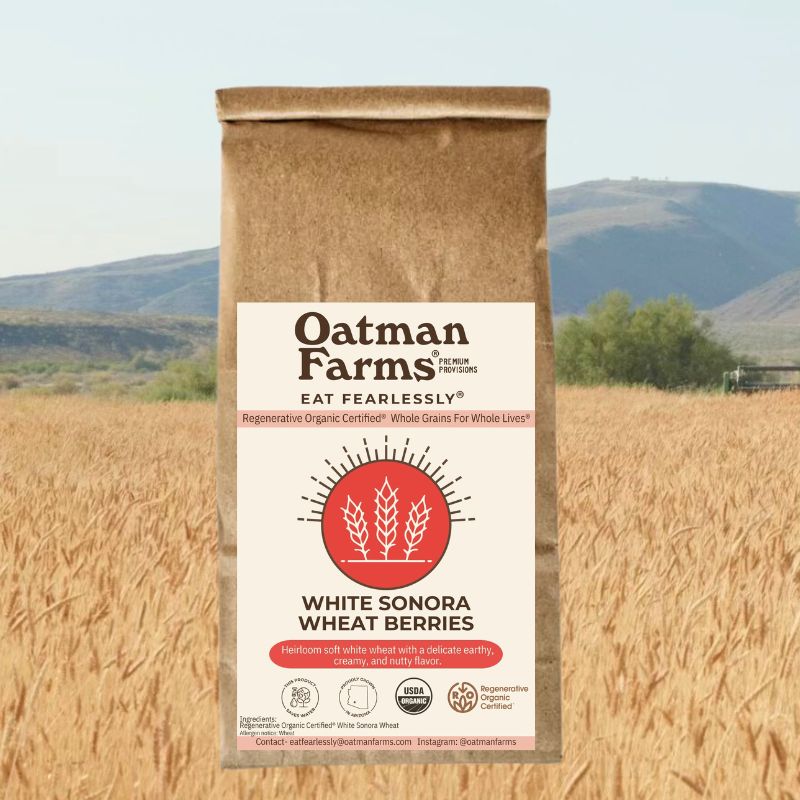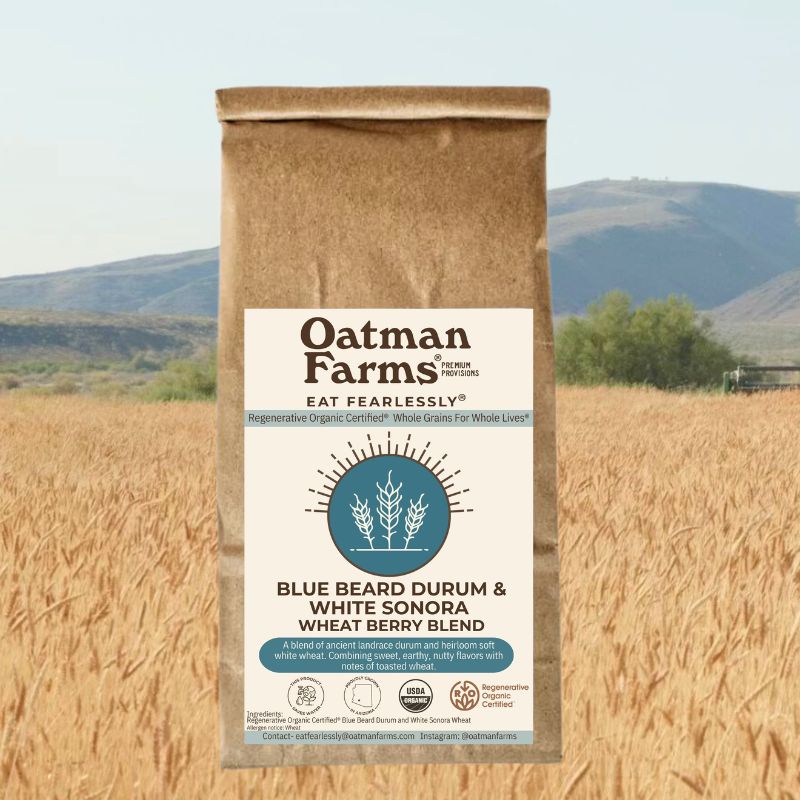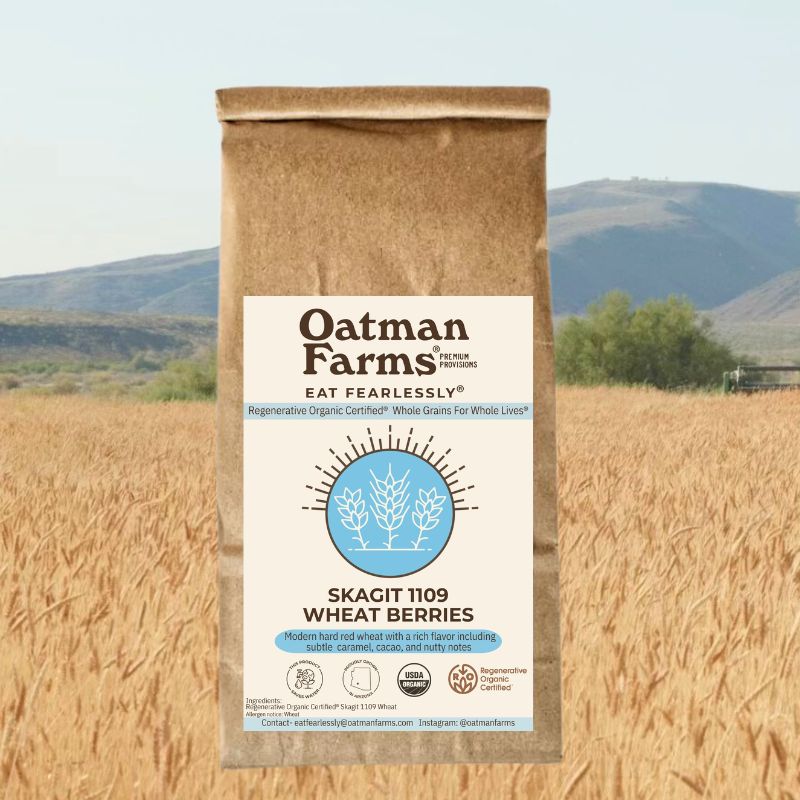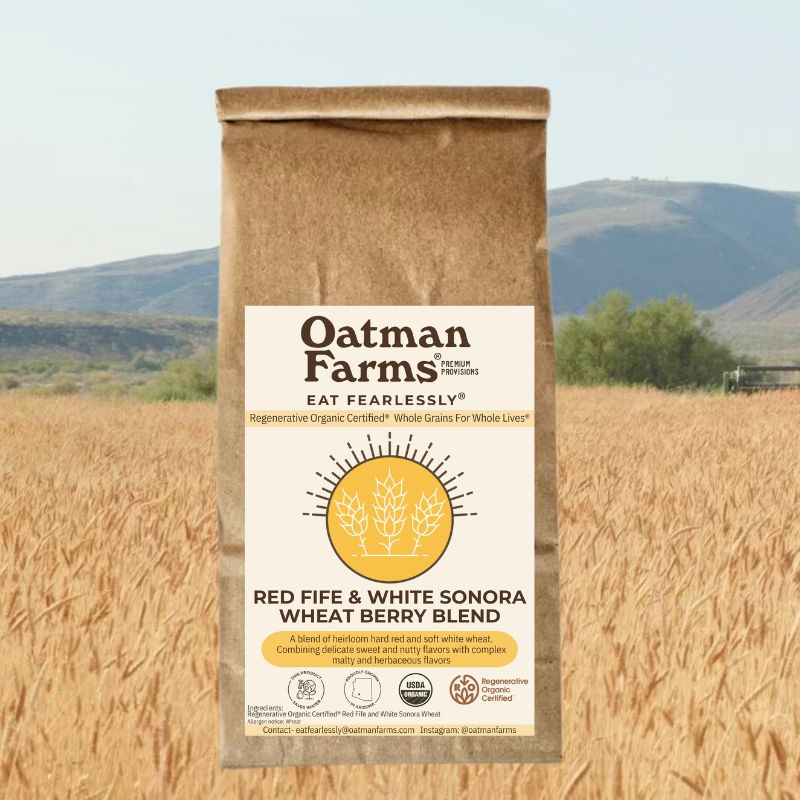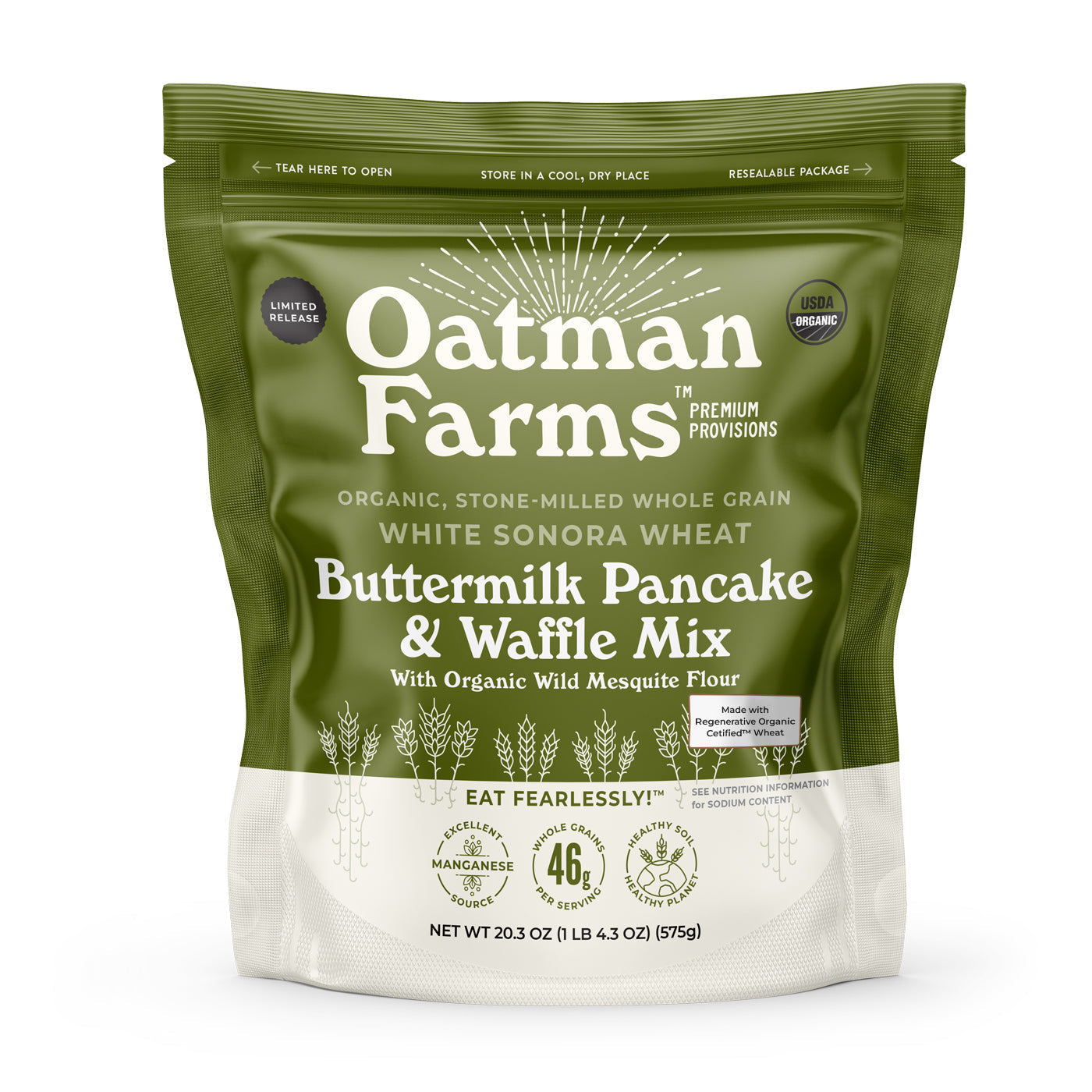Regeneratively grown, stone-ground, and packaged at our farm in Gila, Arizona. This is truly farm-fresh grain for delicious bakes you can feel good about. Learn more about our 2025 desert resilient crops below.
Regeneratively grown, stone-ground, and packaged at our farm in Gila, Arizona. This is truly farm-fresh grain for delicious bakes you can feel good about. Learn more about our 2025 desert resilient crops below.
Classification: Heritage soft winter wheat.
White Sonora wheat offers a mild, slightly sweet flavor with a hint of nuttiness, making it ideal for pastries, cookies, cakes, muffins, and flour blends. This soft, white winter wheat, introduced by Spanish missionaries over 300 years ago, is one of North America's oldest wheat varieties. Grown extensively by the native Akimel O'odham in Arizona, this unique grain nearly vanished under industrial agriculture but now thrives again at Oatman Farms. With a faint off-white color and light gold speckles, it offers a delicate, creamy wheat flavor and low gluten content.
Ideal for cakes, pastries, and tortillas, White Sonora transforms ordinary baking into an extraordinary culinary experience while supporting desert ecosystem restoration.
Classification: Heritage soft winter wheat.
White Sonora wheat offers a mild, slightly sweet flavor with a hint of nuttiness, making it ideal for pastries, cookies, cakes, muffins, and flour blends. This soft, white winter wheat, introduced by Spanish missionaries over 300 years ago, is one of North America's oldest wheat varieties. Grown extensively by the native Akimel O'odham in Arizona, this unique grain nearly vanished under industrial agriculture but now thrives again at Oatman Farms. With a faint off-white color and light gold speckles, it offers a delicate, creamy wheat flavor and low gluten content.
Ideal for cakes, pastries, and tortillas, White Sonora transforms ordinary baking into an extraordinary culinary experience while supporting desert ecosystem restoration.
Classification: Ancient landrace durum.
This ancient durum wheat variety offers a nutty, slightly sweet profile perfect for pasta and Mediterranean dishes.
Blue Beard Durum wheat's high protein content and exceptional taste make it a sought-after choice for bakers, chefs, brewers, and artisanal millers. Each package represents both culinary excellence and your direct contribution to preserving agricultural biodiversity for future generations.
Classification: Ancient landrace durum.
This ancient durum wheat variety offers a nutty, slightly sweet profile perfect for pasta and Mediterranean dishes.
Blue Beard Durum wheat's high protein content and exceptional taste make it a sought-after choice for bakers, chefs, brewers, and artisanal millers. Each package represents both culinary excellence and your direct contribution to preserving agricultural biodiversity for future generations.
Classification: Modern hard red winter wheat
Skagit 1109 is a hard red winter wheat renowned for its rich, nutty flavor profile, complemented by subtle notes of caramel, cacao, coffee, and nuts. This distinctive taste makes it an excellent choice for rustic breads and bakery items, appealing to those who value both quality and sustainability.
Developed by The Bread Lab at Washington State University, Skagit 1109 was specifically bred for whole grain applications, aiming to provide high yields for organic farmers without the need for chemical interventions. Its development supports sustainable and organic agriculture by offering a resilient crop that thrives in diverse environments, thereby promoting innovative farming practices that prepare for changing growing conditions.
Classification: Modern hard red winter wheat
Skagit 1109 is a hard red winter wheat renowned for its rich, nutty flavor profile, complemented by subtle notes of caramel, cacao, coffee, and nuts. This distinctive taste makes it an excellent choice for rustic breads and bakery items, appealing to those who value both quality and sustainability.
Developed by The Bread Lab at Washington State University, Skagit 1109 was specifically bred for whole grain applications, aiming to provide high yields for organic farmers without the need for chemical interventions. Its development supports sustainable and organic agriculture by offering a resilient crop that thrives in diverse environments, thereby promoting innovative farming practices that prepare for changing growing conditions.
Classification: Hard red winter wheat.
Red Fife was the baking and milling industries' standard of wheat in Canada that disappeared during the great depression. It was reintroduced to North America 10 to 15 years ago. The wheat flour has a light-cream color with brown speckles and has a deeper and more complex flavor than common hard red winter wheats. Breads made with it bake up moister, with a cohesive crumb. Traditionally used for breads and dinner rolls.
Classification: Hard red winter wheat.
Red Fife was the baking and milling industries' standard of wheat in Canada that disappeared during the great depression. It was reintroduced to North America 10 to 15 years ago. The wheat flour has a light-cream color with brown speckles and has a deeper and more complex flavor than common hard red winter wheats. Breads made with it bake up moister, with a cohesive crumb. Traditionally used for breads and dinner rolls.
Classification: Prosopis glandulosa and Prosopis velutina.
Mesquite trees are native to northern Mexico, Southern California, Arizona, Utah, and New Mexico and have been used by indigenous groups as a food source for many generations.
The mesquite tree produces a pod or bean that can be ground into flour or cooked whole in water to produce beverages. The mesquite flour is considered a super food by many and provides a great source of vitamins and minerals, including calcium, fiber, protein, and amino acids.
Its delicious sweet taste and low glycemic index helps to satisfy hunger, and stabilize blood sugar, making it an ideal sweetener. To learn more about mesquite click here.
Classification: Prosopis glandulosa and Prosopis velutina.
Mesquite trees are native to northern Mexico, Southern California, Arizona, Utah, and New Mexico and have been used by indigenous groups as a food source for many generations.
The mesquite tree produces a pod or bean that can be ground into flour or cooked whole in water to produce beverages. The mesquite flour is considered a super food by many and provides a great source of vitamins and minerals, including calcium, fiber, protein, and amino acids.
Its delicious sweet taste and low glycemic index helps to satisfy hunger, and stabilize blood sugar, making it an ideal sweetener. To learn more about mesquite click here.
